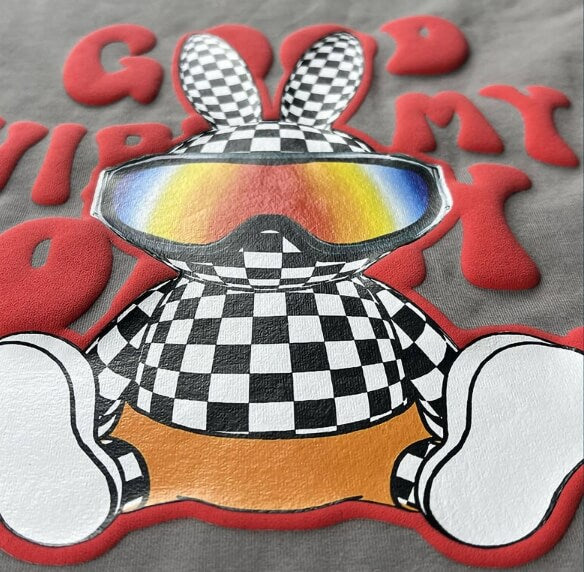How to Use Puff Vinyl & Heat Press Settings
Have you seen those shirts with raised designs, like numbers or logos, that almost pop off the fabric? That’s likely puff vinyl, giving a cool 3D effect.
Want to try puff vinyl to create your own eye-catching, raised designs but unsure if the heat press settings differ from regular vinyl? You’re not alone.
In this post, we will walk you through how to style your clothes with puff heat transfer vinyl and nail the right heat press settings for the perfect finish.
In This Article
- What Is Puff Heat Transfer Vinyl?
- Tools and Materials Needed
- Step-By-Step Guide on Using Puff Vinyl
- Puff Vinyl Project Design Ideas
- FAQs of Using Puff Vinyl
What Is Puff Heat Transfer Vinyl?
Tools and Materials Needed
Puff Vinyl

Cutting Machine
You need a dedicated vinyl cutter, like xTool M1 Ultra. It’s a versatile crafting machine with a range of other cutting abilities.
M1 Ultra has a dedicated fine-point blade for vinyl. But you can easily switch the cutting module for laser cutting, color printing, and even pen drawing. With just one machine, you can do a lot more than cutting vinyl.


xTool M1 Ultra
Multi-functional Vinyl Cutter
It features blade cutting specialized for vinyl cutting, and laser cutting, painting and drawing for various craft needs.
Learn MoreCutting Mat
Get a cutting mat to place underneath the vinyl during the cutting. It not only protects the work surface but also holds the puff vinyl in place, making sure cutting goes smoothly.

Weeding Tool
Once your design is cut, the weeding tool is needed to remove all the little bits of excess vinyl. It helps you get into the fine details for a flawless design.

Heat Press
Since puff vinyl needs even heat and pressure to achieve that raised look, a regular iron won’t work. You need a heat press for proper design transfer.
If you’re looking for options, xTool Heat Press is a great tool to consider. It’s lighter than many standard presses, and its modular design makes it easy to use on different-sized substrates.

Step-By-Step Guide on Using Puff Vinyl
Now, with tools gathered on your table, let’s start making a project with 3D puff heat transfer vinyl:
Step 1: Creating the Design
Create the simple design you need to transfer on t-shirts – it can be text, logos, or cartoon silhouettes. If you’re sourcing a design file from the Internet, get an SVG format file.
When making or choosing a design, keep in mind the puffing/expansion effect. Don’t place small elements too close together. Any intricate or fine details may blur or overlap once the vinyl puffs up.
Step 2: Cutting the Puff Vinyl

Place the puff vinyl with the shiny/glossy/colored side facing the cutting mat, and load it into your xTool M1 Ultra. Connect your device to your PC, and import the design file into the control software. Make sure to mirror the design before cutting it.
For puff vinyl, switch to the fine-point blade to achieve sharp cuts. Set the cut pressure to 90 and the speed to 100.
Step 3: Wedding Out the Excess Vinyl
Using a weeding tool, carefully pick and peel away the negative spaces from your design. This includes all the vinyl that isn’t part of your final design.
Make sure to get into all the small areas and ensure there are no stray patches left attached. If left attached, the stray pieces could ruin your final outlook.
Step 4: Preparing the Surface
Any creases on the shirt can affect how the vinyl adheres and expands. Lay it on a flat surface and make sure it’s dry and wrinkle-free. Pre-press it for 5 to 10 seconds to remove moisture and smooth the surface for better vinyl adherence.
Step 5: Applying the Vinyl with A Heat Press
Set the heat press of pre-heating. If you’re using xTool Heat Press, the green light will turn on, indicating the preheating is completed.

Place the vinyl design face up on the shirt. Puff vinyl requires medium pressure, so apply even pressure across the entire design using the press. Set your heat press to 150°C (305°F) and the timer to 15 seconds.

RELATED: heat transfer vinyl heat press temperature and time guide
Just as the timer goes off, peel off the vinyl sheet backing. As you peel, you will see the design has puffed up, giving it that signature 3D effect.

Puff Vinyl Project Design Ideas
Now, let’s talk about creative projects you can create with puff vinyl:
1. Personalized Name Tees

People love customized shirts, and puff vinyl takes it to the next level by adding a dimensional effect. Initials, names, or favorite quotes in solid vinyl look clean and decent.
2. Animal Silhouettes
If you’re an animal lover, why not showcase that with puff vinyl? Silhouettes of your favorite animals get an eye-catching, 3D effect with puff vinyl.
3. Holiday Themed Shirts

Make your holiday outfits fun by adding raised snowflakes, Santa hats, or ornaments with puff vinyl for a festive look. You can also create spooky Halloween designs like pumpkins or ghosts that jump out with that puffy effect.
4. Sports Apparel

You can layer names and numbers to the back of t-shirts but with a twist. Whether for a team or a fan, the raised look makes sports gear pop, giving it a professional touch.
5. Cartoon Character Shirts

Kids will love vibrant, puffy cartoon characters like dinosaurs, unicorns, or rockets! You can even add an educational twist with puff vinyl numbers or alphabet designs.
FAQs of Using Puff Vinyl
Is puff vinyl durable?
Yes, puff vinyl is as durable as standard HTV when handled with care. Expect it to last through 50 to 100 cycles if maintained properly.
Can I wash puff vinyl shirts?
After the heat transfer, wait at least 24 hours before washing. Turn the shirt inside out, use cold water, and stick to mild detergents to preserve the puff effect.
How long should I heat press the puff vinyl?
Press puff vinyl at 150°C (305°F) for 10-15 seconds to achieve proper adhesion and puffing.
Is puff vinyl hot or cold peel?
Puff vinyl is a hot peel, meaning you should remove the backing immediately after pressing to allow the puff effect to fully form.
Can you layer puff vinyl?
You can layer puff vinyl on top of regular HTV, but you cannot layer anything on top of puff vinyl as it could affect the puffing process.


